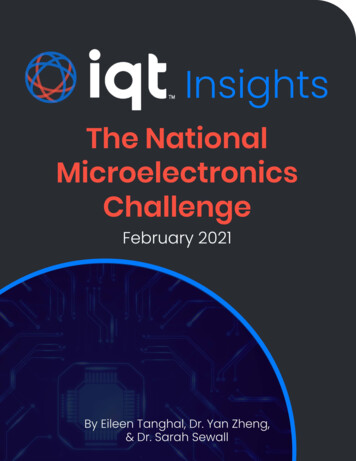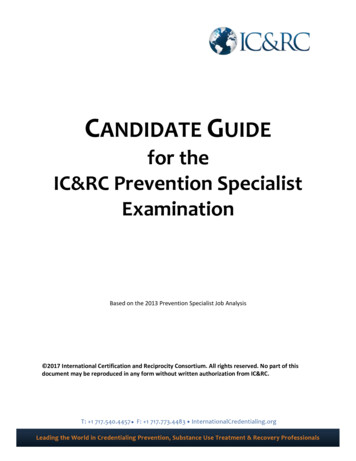
Transcription
IQT Insights: The National Microelectronics ChallengeGrowing U.S. concerns about national microelectronics competitiveness and supply chain securityhave prompted proposals for government action. 1 This policy brief explains IQT’s view thatinnovation is the key to meeting both competitiveness and security challenges. The paper arguesthat the nation should address impediments to commercial success in the specific microelectronicstechnologies that matter most for U.S. security and competitiveness. In so doing, governmentcan better align private sector incentives with the national interest.IQT recognizes the value of boosting federal research anddevelopment and building U.S.-based chip manufacturingfacilities. In IQT’s assessment, however, it is equallyimportant to support priority technologies (e.g., tooling,packaging) with commercialization support. Governmentcould support the creation of “sandboxes” to help transitionfederally funded research from lab to market. Additionally,government could invest in emerging companies where theprivate sector is not funding specific key technologies at alevel commensurate with the national interest. This policybrief, written for the non-expert, provides background andanalysis (Section I) and recommendations (Section II).“The nation mustaddress impedimentsto commercialsuccess in specificmicroelectronicstechnologies thatmatter most.”IQT is a non-profit strategic investor that helps deliver emerging technologies to multiple U.S.national security agencies. This analysis flows from our role as one of the world’s most prolificinvestors operating at the intersection of national security, technology trends, and the privatesector.Section I. Background and AnalysisMicroelectronics are small electronic components (e.g., transistors, inductors, diodes, capacitors)or complex systems (e.g., microprocessors, AI accelerators) which have become vital forpowering everything from smart phones to the most advanced military systems. They provide thebuilding blocks of advanced technologies such as artificial intelligence (AI) and biotechnology.The following section provides a brief overview of the evolution of the industry, technology trends,security considerations, and private sector investment gaps related to microelectronics productionand supply chain security.Industry EvolutionThe United States pioneered semiconductor research since the early 20th century, but it was notuntil its widespread use in radar, radios, and later as the heart of computer systems, didsemiconductors become nearly synonymous with microelectronics. U.S. firms led the rapidlygrowing commercial market and dominated it globally for decades. As the role of semiconductorsgrew, the industry evolved. Today the microelectronics production process – from materials anddesign to manufacturing and packaging – is disaggregated and highly globalized. A single chipmay traverse 70 countries before its production is complete. 2The United States still leads the global industry in several key areas, such as the design of chipsand specialized manufacturing tooling, that represent the highest end of the value chain andThe FY21 National Defense Authorization Act includes several new microelectronics initiatives, verturned-senate.aspx. The National Security Commission on Artificial Intelligence2020 Interim Report and Third Quarter Recommendations also offer recommendations on microelectronics, seehttps://drive.google.com/file/d/1jg9YlNagGI 0rid-HXY-fvJOAejlFIiy/view.2S. Alam, T. Chu, S. Lohokare, S. Saito, M. Baker (2020). Globality and Complexity of the Semiconductor Ecosystem. Accenture andGSA. https://www.accenture.com/ -Industry.pdf 1 2021 In-Q-Tel, Inc.Page 1
IQT Insights: The National Microelectronics Challengeannual markets of 419B 3 and 100B 4, respectively. The U.S. lead in design has proved critical inkeeping U.S. innovation at the cutting edge of technology development. American companies’strength in tooling equipment also has helped constrain the ability of potential adversaries todevelop more advanced manufacturing facilities. However, many other countries’ firms areincreasingly innovative and important in areas of U.S. strength. Moreover, new aspects ofmicroelectronics on which the United States has not previously focused its research or commercialactivities, such as packaging and materials, will likely assume greater significance as the industrycontinues to evolve.To date, the most significant change to the microelectronics ecosystem is the migration ofmanufacturing to Asia. In 1990, the United States and Europe produced three-quarters of globalcapacity. 5 Relative labor costs, differing environmental sensitivities, and government willingnessto help fund large capital investment helped shift much of this manufacturing East. A large Asiannetwork of suppliers and services, including fabrication (production of chips), packaging,assembly, and testing has developed.Fabrication is a particular U.S. concern. Korea and Taiwan host the dominant “merchantfabrication” facilities, with capacity largely reserved for big chip companies. This poses challengesfor small design companies, design startups, and chip customers that require only small batchesof testing or production. For U.S. companies, overseas manufacturing introduces additionalfriction as well as security concerns, including the risk of compromising their intellectual property.U.S.-based company Intel has maintained fabrication facilities dedicated for their own chipproduction. However, the majority of U.S. chip designers are now “fabless,” meaning that theysend their designs to be tested and produced by foreign merchant fabs. Large corporations suchas Qualcomm, AMD, and Apple easily access these facilities for their million-chip runs, but startupsthat require small volume runs and companies designing specialized chips often struggle to gainaccess to production facilities.ChinaChina undoubtedly will become an increasingly large player in the global microelectronics industry.The Chinese government employs national technology strategies, state spending, intellectualproperty theft and forced technology transfer, and integration of civilian and military researchand development efforts to support its ambitious microelectronics goals. Chinese firms alsoreceived the single largest share of global venture financing for microelectronics in 2019, with40% of investment (at higher average dollar amounts) compared to 25% to U.S. companies and18% to the U.K. and Europe. 6While previous state-led efforts to develop Chinese microelectronics capacity were largelyunsuccessful, China is now pursuing the path taken by Japan and Korea, using the developmentof memory as a stepping stone to create more sophisticated microelectronics products. Marketdemand will reinforce the state’s push to reach self-sufficiency in production by 2025. China buys53% of the world’s chips and relies on foreign countries for approximately 84% of its internalGartner: Market Share: Semiconductors by End Market, Worldwide, 2019. Published 6 April 2020. By Andrew Norwood, JonErensen, George Brocklehurst, Ben Lee, Alan Priestley, Bill Ray, Roger Sheng, Amy Teng, Joseph Unsworth, Masatsune Yamaji, JuhiGupta, Anushree Verma, Rajeev Rajput, Kanishka Chauhan, Nolan Reilly4Gartner: Forecast Analysis: Semiconductor Capital Spending and Manufacturing Equipment, Worldwide, Published 14 October2020.By Gaurav Gupta (VP Analyst) and Bob Johnson (VP Analyst).5Fitch, Asa; Santiago, Luis. “Why Fewer Chips Say “Made in the U.S.A.”, Wall Street Journal, 3 November 2020.6In-Q-Tel analysis January 2018 using Pitchbook data3 2021 In-Q-Tel, Inc.Page 2
IQT Insights: The National Microelectronics Challengesemiconductor consumption. 7 Although China’s other domestic manufacturing facilities are lessadvanced, China’s Semiconductor Manufacturing International Corporation is working towardcutting-edge (7 nanometer node) technology, nipping at the heels of global industry leadersTaiwan Semiconductor Manufacturing Company (TSMC) and Samsung.In considering the future evolution of the microelectronics industry, it is reasonable to assumethat China will continue to improve its technological capabilities, ultimately achieving 5 or 3nanometer technology. Additionally, the United States should assume that some foreigngovernments, particularly China, will subsidize national firms in order to hold market share in thiscritical industry. Both factors highlight the importance of continued U.S. technology innovation.Technology TrendsThe microelectronics industry is on the verge of significant change. For decades, it relied onshrinking transistor sizes to squeeze more integrated circuits onto a silicon chip, doublingperformance every two years while reducing costs. This phenomenon, knowns as Moore’s Law,enabled the shift from minicomputers to PCs to smart phones and now the cloud. The processbegan to slow over a decade ago and experts predict that transistor scaling will reach its final,smallest capabilities at the 3 nanometer node around 2022-23. Although additional nodes at 2nm and 1.4 nm might be possible, there is a great deal of uncertainty around whether thesenodes would ever become viable.Impending physical limitations on the size of a transistor have begun to reshape microelectronicsmanufacturing. Companies still using CMOS, the predominate technology for digital integratedcircuits, are squeezing additional functions into the remaining capacity of a single chip, however,newer manufacturing approaches combine smaller chips. This new approach relies on producingsmaller, more specialized chips designed for memory, processing, or functions such as AI. Thesesmaller modular chips – called “chiplets” – can be assembled together during the packagingphase. This evolution in approach suggests that government policies should focus less onsupporting the final stages of CMOS evolution than upon more disruptive technologies such asAdvanced Packaging.Security ConcernsThe United States has concerns about both the reliability of (i.e., continued access to) the globalsupply chain and the security of microelectronics components produced overseas. In weighingpublic policy solutions, issues include the feasibility of replicating manufacturing capacity giventhe size and scope of the global supply chain, the relative costs and benefits of facilities operatedby government versus the private sector, and the degree to which alternative technologicalapproaches could assure the security of components produced overseas. There is no silver bulletto ensure reliability and security of all microelectronics; prioritization and, as is the case incybersecurity, a layered approach that features continued technology innovation will be essential.The Department of Defense’s main concern is ensuring a steady supply of secure microelectronicscomponents to maintain its legacy systems. DOD consumes a (relatively) small number ofdifferent types of chips, which makes production relatively inefficient (akin to the challenges thatstartups and specialized chip designers face in seeking production for their limited chip runs).DOD operates a number of older manufacturing facilities and uses a Trusted Access ProgramOffice (TAPO) to certify as “trusted” fabrication facilities and component suppliers that meet itssecurity standards. However, commercial fabrication processes have advanced beyond those in7These are 2019 figures. Pete Singer, “ISS: The 2020 China Outlook”, Semiconductor Digest, January 28, 28/iss-the-2020-china-outlook 2021 In-Q-Tel, Inc.Page 3
IQT Insights: The National Microelectronics ChallengeDOD-certified facilities. DOD therefore is seeking ways to guarantee reliable and secure cuttingedge production. One approach would be constructing a more advanced dedicated facility inpartnership with a credible American firm. However, this could cost upwards of 15 Billion 8 perfacility and, given 10-year construction timelines, would no longer represent the cutting edge bythe time of operation.An alternative approach is a government partnership with the private sector to build and operatea facility, ideally one able to accommodate limited runs from U.S. design firms. This would benefitfabless startups and small companies by improving production access and reducing securityconcerns; a dual-use facility also would help ensure the full utilization of manufacturing capabilityand thus profitability of the plant. In an encouraging initiative, Taiwan’s TSMC recently committedto open a relatively small but cutting edge (5 nanometer) commercial fabrication plant in Arizonain 2024, thanks to a financial partnership with the U.S. government and the state of Arizona. 9Foreign ownership of U.S.-based manufacturing (whether TSMC or GlobalFoundries) may not fullyaddress security concerns, but it is critical to acknowledge that vulnerabilities are likely to persisteven in U.S.-owned manufacturing facilities.Further, on-shoring capacity may help ensure supply reliability, but it cannot necessarilyguarantee component security. In the long run, then, a layered approach to security that assumeszero trust of a given product is required. This must include developing new approaches to assessthe relative security of globally or domestically produced components as well as designarchitectures that mitigate risks.Innovation is the key for creating new tools and layered processes to secure or validate thesecurity of chips regardless of their origin. Such a “zero-trust security” approach would benefitcommercial as well as DOD consumers. Already, DOD and the Intelligence Community havesponsored research to combine state-of-the-art commercial processes with post-processingtechniques to ensure chip security. One such effort involved shipping half-completed commercialmaterials to be completed through a certified secure process. Other research efforts integratedprefabricated and pre-screened chiplets together to create secure products.Additional research support is needed to accelerate creation of a zero-trust security regime,specifically for DOE, NSF, DOD, and DARPA to produce novel hardware security technologies andfor NIST to improve hardware security standardization. Policies can be mutually reinforcing. Forexample, to ensure there is demand and uptake of hardware security features, the United Statesmight require that devices that collect personally identifiable information also have basic securityfeatures such as a hardware root of trust, trusted enclaves, and unique device identification,depending on the application. An independent certification lab for hardware security could becreated to ensure that products meet security standards for the United States and its keyinternational partners.Private Sector Investment GapsThe United States has long relied upon private sector innovation in the microelectronics industry.Based on current trends, however, private sector investment is inadequate in areas that IQTconsiders critical for U.S. innovation leadership and commercial strength.Christian G. Dieseldorff, “Nearly 50 Billion in Fabs to Start Construction in 2020,” Semi, September 12, n-20209TSMC, “TSMC Announces Intention to Build and Operate Advanced Semiconductor Fab in the United States,” TSMC News Archives,May 15, 2020, https://pr.tsmc.com/english/news/20338 2021 In-Q-Tel, Inc.Page 4
IQT Insights: The National Microelectronics ChallengeThere is plentiful private sector investment in “fabless semiconductor” companies that designspecialized advanced chips because they often offer “exits” (sales or IPOs) that can providesignificant returns. However, other specific microelectronics areas that are important from anational competitiveness perspective have been underfunded. For example, design software andthe associated intellectual property (reusable circuit designs that can be put together like Lego blocks to make larger complex chips) offer less attractive returns compared to other softwareinvestments. Likewise, microelectronics hardware offers modest returns over longer timeframes,while requiring significant upfront capital investment. This deters private investment, even thoughhardware remains vital for overall U.S. microelectronics innovation and security.Tooling – the equipment needed for cutting-edge manufacturing – is an area of particularconcern. The United States leads in advanced tooling technologies (along with Dutchmanufacturer ASML, the sole producer of advanced lithography (EUV) tools). Notably, exportcontrol of tooling has provided leverage over the pace of other nations’ advances in manufacturing(and even other nations’ export of chips made using advanced U.S. equipment). This is how theU.S. is preventing Huawei from buying certain Application Specific Integrated Circuits (ASICs)from TSMC in Taiwan, although this approach reinforces Chinese determination to develop itsown leading-edge chip production.The future need, which faces a private sector investment shortfall, is next-generation patterningtechnologies. These include “direct write” tooling, which removes a significant step in themanufacturing process, and novel deposition tools to accommodate new materials such asgraphene, carbon nanotubes, organic and compound semiconductors, and others. (As notedearlier, IQT would prioritize new materials, along with zero-trust security verification technology,in any additional research funding). The combination of new tools and materials is likely to be atruly disruptive to the industry and therefore of geopolitical significance as China invests heavilyin catching up in current technologies.U.S. startups that explore these critical opportunities face difficulties raising funds, however. Ofthe 215 U.S. microelectronics companies that received private funding during 2015-2017, onlyfive were design software firms, eight sold novel tooling equipment, and nine were insemiconductor IP. 10 The private financing landscape may only become more challenging. Overthe past decade, foreign capital had been a significant source of funding for microelectronicsstartups – particularly in later stage financing. In recent years, as the U.S. tightened restrictionson foreign investment, the percentage of foreign financing of U.S. microelectronics firms hasshrunk. 11 Today, American venture capital provides a smaller portion of financing formicroelectronics than it does for information technology overall. Other sources of funding,including from government entities such as NASA, DOE, DARPA, and NSF, have been crucial formaintaining even the current level of microelectronics startup activity. 12 In sum, there is a dearthof trusted private investment in the microelectronics startups of the greatest potential nationalsecurity import.Section II. RecommendationsThe U.S. microelectronics industry faces unique challenges and risks falling short in specific areasof innovation that advance the national interest. Government should consider targeted action toaddress impediments to commercial success in those technologies that matter most for U.S.In-Q-Tel analysis January 2018 using Pitchbook dataIn-Q-Tel analysis January 2018 using Pitchbook data12In-Q-Tel analysis January 2018 using Pitchbook data1011 2021 In-Q-Tel, Inc.Page 5
IQT Insights: The National Microelectronics Challengesecurity and competitiveness. In so doing, government can better align private sector incentiveswith the national interest.IQT recognizes, as discussed in Section I, that proposals to boost research funding and buildfabrication facilities can help promote U.S. microelectronics reliability and security objectives.IQT’s recommendations below highlight additional needs that have received less attention frompolicymakers, specifically, i.) creating commercialization infrastructure to help translate U.S.investment in research into products and ii.) investing in emerging companies where privatesector funding is not investing at levels commensurate with national security requirements. Asexplained in Section I, IQT sees tooling and packaging as priorities for greater support.Commercialization InfrastructureThe innovation pipeline begins with basic research, extends to prototyping and development, andleads to productization, commercialization, and sustainable, successful companies. The UnitedStates historically has invested in the early part of the innovation pipeline, providing researchfunding to national labs, academia, and industry. This research creates intellectual property (IP)that has the potential to help meet government needs and yield other commercial applications asidentified by the private sector. Yet, for a variety of reasons, much of this early IP is notsuccessfully commercialized. The challenge of moving IP beyond R&D and through the fullpipeline is sometimes referred to as the “valley of death” or “crossing the chasm.” To fully realizeits initial investment in research and development, the United States must take steps to supportcommercialization efforts later in the pipeline, helping research investments lead to viableproducts and businesses.Microelectronics companies face some unique hurdles – in particular, gaining affordable accessto small production runs that enable the creation and adaptation of prototypes that fit marketneeds that can attract private capital. The creation of facilities and communities to help addressthese hurdles will not only help realize research investments and move technology across thechasm to products, it will unleash private capital in support of this process and promote thecontinuous innovation required in this dynamic industry.Supportive infrastructure – which can be created via a public-private partnership – should engageboth industry and academia, promote interdisciplinary work, provide access to advancedcommercial equipment to replicate industry requirements, and enable feedback loops fromcommercialization back to research. The United States needs commercialization infrastructure forboth the front and back ends of the microelectronics production process. Tooling and Bespoke ProductionA national facility to field innovative semiconductor tools and fabricate next-generationmicroelectronics products in areas critical to national security would help speedinnovation and unlock private investment. Variations on this idea have been called amicroelectronics commons, a national semiconductor center, a Lab-to-Fab facility, and ahardware “sandbox.” Such a facility could provide researchers and firms hands-onaccess to production lines that mirror commercial lines and can be adapted to explorenew tooling capabilities, materials, components, and processes. The facility could alsoallow innovators to test and develop security assurance technologies on various devicesand process flows.A fabrication sandbox could be a win-win proposition in which startups gain access tocommercial equipment and tools, early design validation, and valuable testing data toshare with potential investors while the government gains early access to innovative 2021 In-Q-Tel, Inc.Page 6
IQT Insights: The National Microelectronics Challengetechnology that could be tested against government requirements and inform futuremission planning and acquisition needs. Advanced PackagingThe United States is not a leader in traditional packaging – the end of the productionprocess in which bare chips (called dies) are mounted then wired up through a last layerof electrical connections and enclosed for protection. Yet next-generation packaging isgaining importance as a high-value step because semiconductor functionality isincreasingly derived from the packaging process in addition to what’s on the chip itself.As Moore’s law ends, manufacturers will no longer squeeze more functions onto a singlegeneral-purpose chip, but opt to create custom-built chips by integrating various smallerfunction-specific chiplets instead. Advanced Packaging, in which chiplets of varied andnext-generation materials and process technologies can be combined in three dimensionsinstead of two, is the future of microelectronics customization.The significant costs of creating packaging facilities mean that American industry isunlikely to move into this critical innovation space without support from the government.A dedicated facility could test how U.S. chip designs work with Advanced Packagingprocesses and accelerate the transfer of technology from the lab, helping propel U.S.companies toward leadership in this emerging field. Compared to a leading-edge CMOSfoundry, an advanced packaging facility will greatly impact how microelectronics will bedesigned in the future while costing orders of magnitude less.Investment FundThe follow-on challenge within the innovation pipeline is successful formation and scaling of acommercial enterprise.Market forces may be insufficient to help companies succeed, even when that success servesthe national interest by virtue of the technology. The robust U.S. private equity ecosystem willfund companies where there is a demonstrated market opportunity in the form of revenuetraction and the potential to build value. However, in critical microelectronics niches, U.S.innovation is dwindling because the commercial returns are no longer sufficiently attractive toprivate investors. 2019 data show the U.S. trailing China in both the number of hardwarecompanies receiving investment and the mean size of those investments. Furthermore, theprivate equity and venture community form a much smaller subset of U.S. investors in hardwarethan in the overarching IT industry. While dual-use commercial technology is critical to thenation’s security, responsibility for funding should not rest solely on the shoulders of eitherprivate industry or government.The government needs its own investment vehicles to fill the gaps in the private equity ecosystemwhere the technologies are of national importance. The United States should establish aMicroelectronics Investment Fund targeting key areas such as toolsets, advanced packaging, andorigin-agnostic security technologies. These investments would help ensure that essential anddisruptive technologies receive early funding, and hopefully catalyze private sector investment byhelping de-risk the opportunity. The fund entity would also serve as a central hub for thegovernment to coordinate with the startup community in important dual-use technologies. Evena relatively modest fund of 250 million over five years could accelerate U.S. microelectronicsinnovation in the areas of greatest relevance to the national interest.Examples of companies offering products important for U.S. competitiveness or security but facingdifficulties raising capital include: 2021 In-Q-Tel, Inc.Page 7
IQT Insights: The National Microelectronics Challenge “Direct write” of the semiconductor circuit. Unlike traditional photolithography tools thatneed a special laser and a large number of photomasks to create the designed pattern,this company uses an array of electron beams to directly draw custom patterns withoutneeding any masks.Fully automated optical inspection system for analyzing opaque, transparent, and semitransparent materials for features and defects. The company combines their tool withcomputer vision capabilities to identify manufacturing issues and potentially maliciousinsertions at the nano or macro level more rapidly than manual quality control methods."Lego blocks" approach to assemble chiplets into custom chips in a fraction of the timecurrent processes require.Security processor for embedded systems that prevents the exploitation of softwarevulnerabilities at the hardware level and monitors instructions executed from a hostprocessor to ensure that it complies with a set of security, privacy, safety, or customizedmicropolicies.In addition to creating an investment fund, government can support commercialization throughother policies. Government might create platforms to systematically midwife potential newcompanies from promising ideas emerging from national research centers (IQT is doing thisthrough IQT Emerge, a new effort focused on commercializing technology innovation from U.S.government-funded R&D initiatives). Agencies could streamline government procurementprocesses to become a better customer for promising startups. The United States could launchtechnology challenges to advance solutions to specific issues like opening up the 5G Radio AccessNetworks or promoting hardware security.ConclusionMicroelectronics remain vital in both civilian and national security spheres; they are building blocksof consequential emerging technologies like AI and biotechnology. The United States need notbecome self-sufficient or dominant in every aspect of microelectronics. But sustaining leadershipin areas of significance, like chip design and tooling, and developing new approaches, such asAdvanced Packaging using new materials, will help keep the United States poised to disrupt theindustry. This is more urgent as a strategic competitor marches toward existing cutting-edgetechnology standards. Where the market will not ensure that leadership or disruption,government should consider policies to align private sector incentives with the national interest.Many microelectronics policy proposals recommend doing more of what the United States hasdone historically in funding R&D and supporting secure fabrication facilities. IQT sees greatpossibility in new approaches to promote the commercialization process and address investmentgaps. Sustaining a U.S. lead in key areas of microelectronics demands continuing innovation inareas that the market may not currently value. The government has an opportunity andresponsibility to help
Growing U.S. concerns about national microelectronics competitiveness and supply chain security have prompted proposals for government action. 1. This policy brief explains IQT's view that innovation is the key to meeting both competitiveness and security challenges. The paper argues










